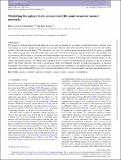Files in this item
Modelling the galaxy-halo connection with semi-recurrent neural networks
Item metadata
| dc.contributor.author | Chittenden, Harry George | |
| dc.contributor.author | Tojeiro, Rita | |
| dc.date.accessioned | 2022-12-19T13:30:04Z | |
| dc.date.available | 2022-12-19T13:30:04Z | |
| dc.date.issued | 2023-02-01 | |
| dc.identifier | 282444038 | |
| dc.identifier | 6eb7e04d-810e-41f5-beaa-fbaaf1ee4723 | |
| dc.identifier | 85146851055 | |
| dc.identifier.citation | Chittenden , H G & Tojeiro , R 2023 , ' Modelling the galaxy-halo connection with semi-recurrent neural networks ' , Monthly Notices of the Royal Astronomical Society , vol. 518 , no. 4 , pp. 5670–5692 . https://doi.org/10.1093/mnras/stac3498 | en |
| dc.identifier.issn | 0035-8711 | |
| dc.identifier.other | Bibtex: 10.1093/mnras/stac3498 | |
| dc.identifier.uri | https://hdl.handle.net/10023/26624 | |
| dc.description | Funding: HGC wishes to thank the UKRI Science and Technology Facilities Council for funding this research, under grant ID ST/T506448/1. | en |
| dc.description.abstract | We present an artificial neural network design in which past and present-day properties of dark matter halos and their local environment are used to predict time-resolved star formation histories and stellar metallicity histories of central and satellite galaxies. Using data from the IllustrisTNG simulations, we train a TensorFlow-based neural network with two inputs: a standard layer with static properties of the dark matter halo, such as halo mass and starting time; and a recurrent layer with variables such as overdensity and halo mass accretion rate, evaluated at multiple time steps from 0 ≤ z ≲ 20. The model successfully reproduces key features of the galaxy halo connection, such as the stellar-to-halo mass relation, downsizing, and colour bimodality, for both central and satellite galaxies. We identify mass accretion history as crucial in determining the geometry of the star formation history and trends with halo mass such as downsizing, while environmental variables are important indicators of chemical enrichment. We use these outputs to compute optical spectral energy distributions, and find that they are well matched to the equivalent results in IllustrisTNG, recovering observational statistics such as colour bimodality and mass-magnitude diagrams. | |
| dc.format.extent | 23 | |
| dc.format.extent | 3676871 | |
| dc.language.iso | eng | |
| dc.relation.ispartof | Monthly Notices of the Royal Astronomical Society | en |
| dc.subject | Galaxies: evolution | en |
| dc.subject | Galaxies: formation | en |
| dc.subject | Galaxies: haloes | en |
| dc.subject | Galaxies: star formation | en |
| dc.subject | QB Astronomy | en |
| dc.subject | QC Physics | en |
| dc.subject | DAS | en |
| dc.subject | MCC | en |
| dc.subject.lcc | QB | en |
| dc.subject.lcc | QC | en |
| dc.title | Modelling the galaxy-halo connection with semi-recurrent neural networks | en |
| dc.type | Journal article | en |
| dc.contributor.institution | University of St Andrews. School of Physics and Astronomy | en |
| dc.identifier.doi | https://doi.org/10.1093/mnras/stac3498 | |
| dc.description.status | Peer reviewed | en |
This item appears in the following Collection(s)
Items in the St Andrews Research Repository are protected by copyright, with all rights reserved, unless otherwise indicated.

